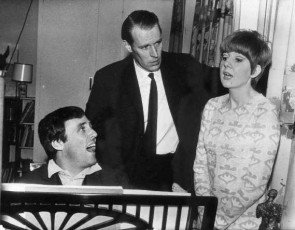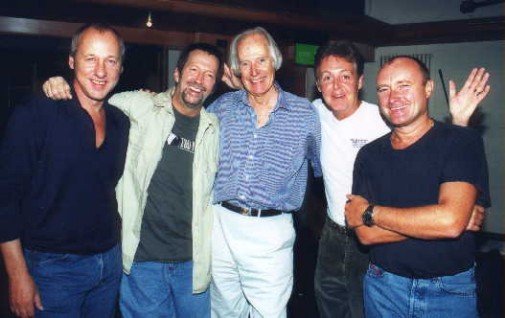EON
Productions movies
1. Dr
No 1962
2. From Russia With
Love 1963
3. Goldfinger 1964
4. Thunderball 1965
5. You
Only Live Twice 1967
6.
On Her Majesty`s Secret Service
1969
7. Diamonds Are
Forever 1971
8. Live And Let Die 1973
9. The Man With The Golden Gun
1974
10.The Spy Who Loved Me
1977
11.Moonraker 1979
12.For Your Eyes Only 1981
13.Octopussy
1983
14.A View To A Kill
1985
15.The Living Daylights
1987
16.Licence To Kill 1989
17.Goldeneye
1995
18.Tomorrow Never Dies1997
19.The World Is Not Enough
1999
20.Die Another
Day 2002
21.Casino Royale 2006
22.Quantum Of Solace
2008
23. Skyfall 2012
24. SPECTRE
2015
25. James Bond
25 2018
26. James Bond 26 2021
Not included in
Bondserie or
EON Productions
Casino Royale 1954
Casino
Royale 1967
Never Say Never Again
1983
Producer
Albert
"Cubby"Broccoli
Harry
Saltzman
Barbara Broccoli
Michael G,Wilson
Writers to all Bond books
Ian Fleming
Amis Kingsley
Raymond Benson
John Gardner
Charlie Higson
Sebastian Faulks
Bondbooks
James Bond actors
Barry
Nelson
Sean Connery
George Lazenby
Roger Moore
Timothy Dalton
Pierce Brosnan
Daniel Craig
James Bond Composers
Monty Norman 1
John Barry 11
George Martin 1
Marvin
Hamlisch 1
Bill Conti 1
Michael Kamen 1
Eric Serra 1
David Arnold 5
James Bond Music
22 Best Bondsoundtrack
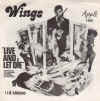
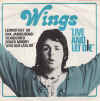
|
Sir George Martin - Composer
and honorary Beatle
Live and Let Die CD Music by Sir George Martin 1973
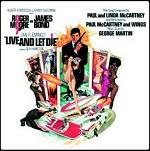
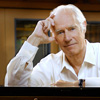 Born in London on 3rd of January
1926, George Martin is probably one of the most famous and respected
producers of his generation, renown for his long-term friendship with the
members of cult English pop band the Beatles, as well as being the first
producer to grant them an audition upon hearing their songs. On the other
hand, George Martin has also composed a handful of movie scores since the
early 1960s, alongside his numerous entries as a producer. Obviously, Sir
Martin is a man of many talents: the sheer amount of work he has put into
the music industry can testify for this. However, his true vocation lies
within score composition, and this is something that many people tend to
overlook due to the overwhelming importance that popular music has in the
eyes of mainstream masses. Born in London on 3rd of January
1926, George Martin is probably one of the most famous and respected
producers of his generation, renown for his long-term friendship with the
members of cult English pop band the Beatles, as well as being the first
producer to grant them an audition upon hearing their songs. On the other
hand, George Martin has also composed a handful of movie scores since the
early 1960s, alongside his numerous entries as a producer. Obviously, Sir
Martin is a man of many talents: the sheer amount of work he has put into
the music industry can testify for this. However, his true vocation lies
within score composition, and this is something that many people tend to
overlook due to the overwhelming importance that popular music has in the
eyes of mainstream masses.
How did Guy Hamilton's "Live and Let Die" win the Evening
Standard British Film Awards in 1975? Most likely due to the soundtrack by
George Martin.
It wouldn't be fair to compare Live and Let Die's score with
John Barry's masterworks in the Bond series, but it's
impossible to deny the impact of this recording, as well as the strong
relation with Barry's material itself. The title track was nominated for
“Best Original Song” at the US Academy Awards in 1974, as well as
receiving the title of “Best Album of Original Score Written for a
Motion Picture” at the Grammy Awards. With Live and Let Die, Martin
manages to capture that special
James Bond Music
sound texture and give it a new lease of life with seedy jazz segments,
much like Lalo Schifrin’s score for Dirty Harry in 1971, and
South-American music, as well as a definite rock feel overall. Giving the
locale of the eighth Bond picture, it’s only natural that the composer
should opt for Latin-American and African rhythms, on top of many
associated musical styles such as Salsa. The film had a love-hate
relationship with audiences and critics alike, even considering the hugely
dissatisfying Diamonds are Forever, released a couple of years before.
However, George Martin’s score is the most energetic and diverse of all
of them.
A Bond score wouldn’t be a Bond score without the mandatory
introductory song, thus Paul and Linda McCartney provide us with the
picture’s main title: “Live and Let Die”. The famous Bond theme can
be heard throughout the soundtrack in it’s blaring and glorious form, in
addition to the many variations based upon it, in tracks "Whisper Who
Dares", "Snakes Alive", "Bond Drops in", "Solitaire
Gets her Cards", "Bond to New York" and of course
"James Bond Theme". In these tracks, George Martin has a great
way of using clichéd material, sounding almost like an American TV-serial
set in the 70's New York. The most interesting variation on the Bond theme
appears in the track "Bond to New York", in which it is played
alongside a high-speed militaristic drum pattern and distinctive 70’s
flute and electric guitar, a nod to Isaac Hayes’ music from Shaft
(Gordon Parks, 1971) in many ways.

Other than the Bond Theme, “New Second Line” is the only
instrumental track on Live and Let Die that wasn’t composed by George
Martin. It’s a charming jazz ballad by trumpeter Milton Batiste,
performed before his major breakthrough in the jazz industry in the early
80’s. "Gunbarrel/Snakepit" is another interesting track in
which Martin opts for an African rhythm, sounding like it could have been
performed on a darbouka drum; the same goes for "Sacrifice",
performed in conjunction with fluttering wind sections this time around.
The closest Martin comes to equating John Barry's mystique can be found in
tracks such as "If he Finds it, Kill him", as well as in certain
sections of "Bond Drops in". These two particular works are part
of the best moments on Martin's soundtrack; they truly capture the
romantic, the perilous, the suaveness, and the idealism of the Bond
formula, with their soft percussion and breezy orchestration.


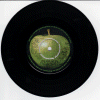

Live and Let Die with title song by Paul McCartney and Wings.
The Vinyl 7″ 45 rpm single
record was introduced in 1949 by RCA.
The Apple records Granny
Smith apple. |
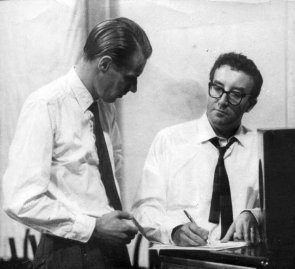
George Martin with Peter Sellers
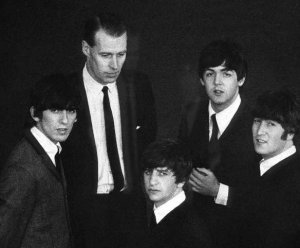
Live And Let Die George Martin with the Beatles
Live and Let Die CD
Music by George Martin 1973
Nr : 007- 20080
THE ORGINAL SOUNDTRACK
Live and Let Die [SOUNDTRACK] 1973
George Martin, Wings, Paul McCartney, James Bond Films (Related
Recordings)
Live and Let Die" (1973) introduced a new Bond,
Roger Moore, and a new musical team, Paul McCartney and
Wings and former Beatle's producer, George Martin, to set
the tone. The primary focus here was to produce a hit
title with Paul and Linda McCarney and Wings. Martin
simply came with the deal. The title remains one of the
most dramatic and best songs of the series, and was
especially striking with Maurice Binder's amazing opening
and end titles. George Martin's score included a
foundation based on the James Bond theme and the title song, but he also introduced a fine theme for
Solitaire,
and interesting island music for "Baron Samedi's
Dance of Death" and "Sacrifice." Without
McCartney and Wings, George Martin would not have sufficed, but together they produced one of the best
non-Barry soundtracks.
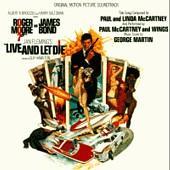
The 8th Bond film Live and Let Die with title song by Paul McCartney and Wings. |






![]()
![]()
![]()
![]()
![]()
![]()
![]()
![]()
![]()
![]()
![]()


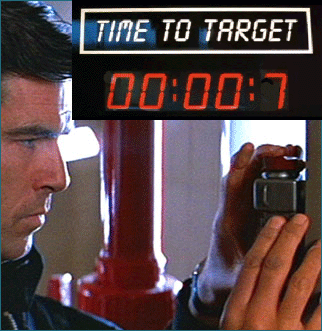
![]()
![]() C
C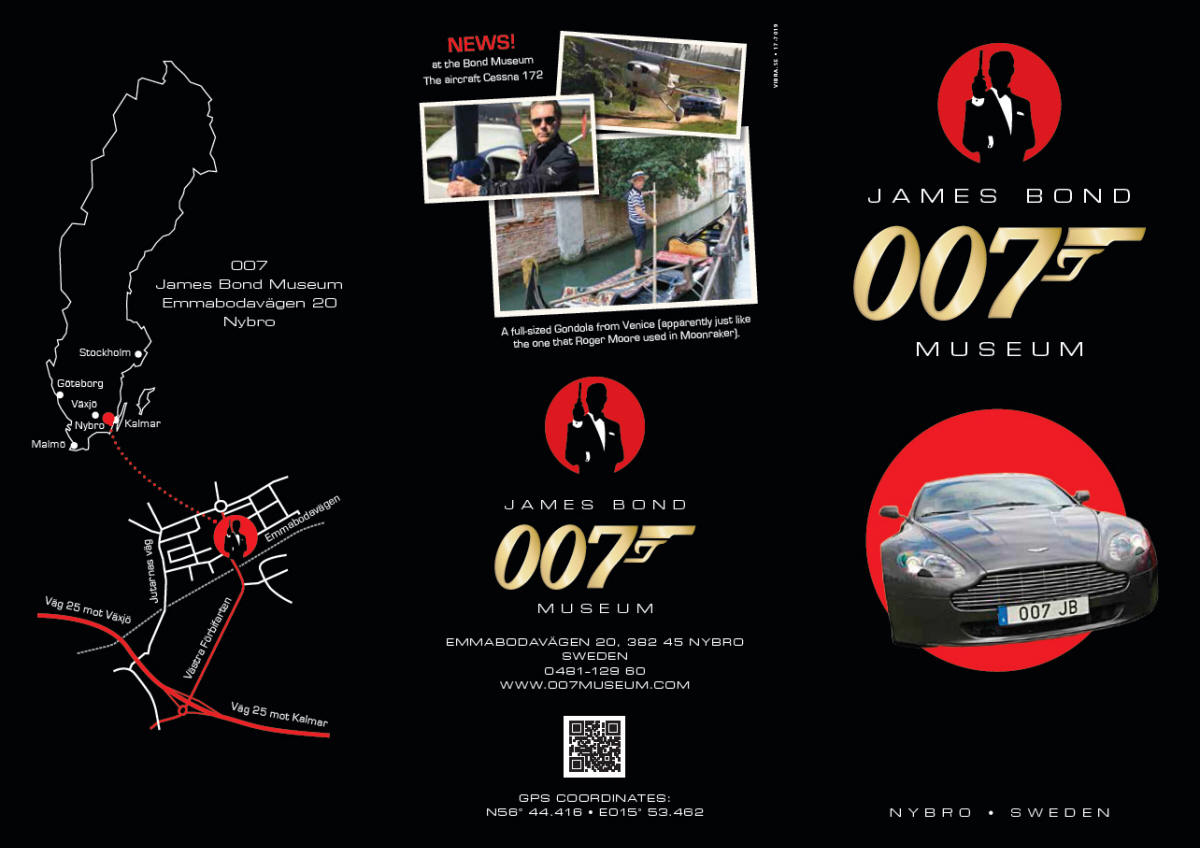



 Born in London on 3rd of January
1926, George Martin is probably one of the most famous and respected
producers of his generation, renown for his long-term friendship with the
members of cult English pop band the Beatles, as well as being the first
producer to grant them an audition upon hearing their songs. On the other
hand, George Martin has also composed a handful of movie scores since the
early 1960s, alongside his numerous entries as a producer. Obviously, Sir
Martin is a man of many talents: the sheer amount of work he has put into
the music industry can testify for this. However, his true vocation lies
within score composition, and this is something that many people tend to
overlook due to the overwhelming importance that popular music has in the
eyes of mainstream masses.
Born in London on 3rd of January
1926, George Martin is probably one of the most famous and respected
producers of his generation, renown for his long-term friendship with the
members of cult English pop band the Beatles, as well as being the first
producer to grant them an audition upon hearing their songs. On the other
hand, George Martin has also composed a handful of movie scores since the
early 1960s, alongside his numerous entries as a producer. Obviously, Sir
Martin is a man of many talents: the sheer amount of work he has put into
the music industry can testify for this. However, his true vocation lies
within score composition, and this is something that many people tend to
overlook due to the overwhelming importance that popular music has in the
eyes of mainstream masses.





